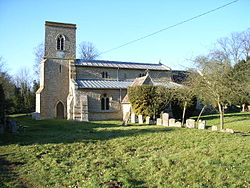Fringford
| Fringford | |
| Oxfordshire | |
|---|---|
 St. Michael's parish church | |
| Location | |
| Grid reference: | SP605289 |
| Location: | 51°57’21"N, 1°7’14"W |
| Data | |
| Population: | 602 (2011) |
| Post town: | Bicester |
| Postcode: | OX27 |
| Dialling code: | 01869 |
| Local Government | |
| Council: | Cherwell |
| Parliamentary constituency: |
Banbury |
| Website: | Fringford Village |
Fringford is a village in Oxfordshire, about four miles north-east of Bicester. To the east runs the Roman road that linked Alchester Roman Town with Roman Towcester. The village is surrounded on two sides by a bend in the tributary of the Great Ouse.
The 2011 Census recorded the parish's population as 602.
Parish church
The parish church, St Michael and All Angels, was first built, it is believed, by the early part of the 12th century, and was granted by the lord of the manor, Baron William de Arsic of Cogges, to the Benedictine Priory he had founded at Cogges. The south aisle may have been rebuilt in the 14th century.[1]
The only maintenance recorded before the 19th century is in 1788, when £18.4.3d. was spent on general repairs.[2]
In 1815 Henry Dawson Roundell was appointed Rector. He is described as "possessed of ample means and genial temperament". He started letting parts of the parish glebe as allotments for labourers in the parish and, throughout his incumbency, he promoted the restoration of the church. After his incumbency the north aisle was rebuilt in 1905 and the roof was restored in 1909.[1]
The Church of England parish of Fringford is now a member of the Benefice of Shelswell, which includes also the parishes of Cottisford, Finmere, Fringford, Godington, Hardwick, Hethe, Mixbury, Newton Purcell, Stoke Lyne and Stratton Audley.
History
At the southern edge of the parish, beside the tributary of the River Bure, there may have been a Roman villa. The site is only about 200 yards west of the Roman road. It is now occupied by Fringford Lodge.[1]
After the Norman conquest in 1066, William of Normandy gave his half-brother Odo, Bishop of Bayeux, manors that included Fringford. Later the King deposed Odo and granted the manor of Fringford to Baron William de Arsic of Cogges.[1]
Fringford in the 19th century is associated with Flora Thompson's Lark Rise to Candleford trilogy, in which Fringford is the prototype for Candleford Green. In 1844 the Oxford Chronicle noted "there aren't enough dwellings to shelter the poor". In 1851 the population was 357. During this time the parish had only a few good farm-houses. The population peaked at 479 in 1871, its highest number until the 1990s.
Fringford had five blacksmiths, three carpenters, three sawyers, three brickmakers, a stonemason, a shoemaker, three decorators, a carrier, a coal haulier, two bakers, two grocers and a butcher. Also two grooms, two footmen, six gardeners and a coachman from Fringford were employed at Shelswell House, Tusmore Park and Swift House.
Mains electricity was not supplied until after the Second World War and mains water until 1960.
Outside links
| ("Wikimedia Commons" has material about Fringford) |
- Fringford Village
- Fringford C of E Primary School
- "Brief History of Fringford". Shelswell Parishes. http://www.shelswellparishes.info/fringford/history.html.
References
- Blomfield, James Charles (c. 1890). Part V: History of Fringford, Hethe, Mixbury, Newton Purcell, and Shelswell. Deanery of Bicester. London: Elliot Stock & Co.
- Greenwood, Martin W (2000). Fringford Through the Ages. Martin Greenwood. ISBN 0-9539627-0-9.
- A History of the County of Oxford - Volume 6 pp 125-134: Parishes: Fringford (Victoria County History)
- Nikolaus Pevsner: The Buildings of England: Oxfordshire, 1974 Penguin Books ISBN 978-0-300-09639-2

